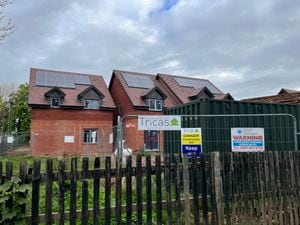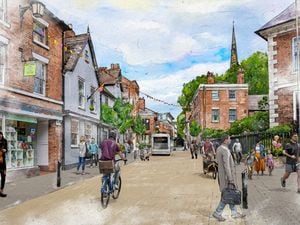Housing crisis in the countryside
Overcrowded tenements in inner cities. Tiny flats in London tower blocks selling for seven-figure sums. Homeless people bedding down for the night in the foyer of the railway station.

Certainly, from the way the housing crisis is portrayed in the national media, one could be forgiven for thinking it is an almost exclusively urban problem.
But according to Paul Miner of the Campaign to Protect Rural England (CPRE), the biggest housing crisis is taking place in leafy counties such as Shropshire.
"Take a walk in the countryside on a warm summer’s day and you’ll see cows lazing in the sun, green hills and valleys, lanes bordered by bustling hedgerows," he says.
"But you’re also increasingly likely to come across vacant Post Offices, boarded-up pubs and crumbling village halls. These are all-too-common reminders of the challenges faced by rural communities, and a symptom of the housing crisis gripping England’s countryside."
Mr Miner points out that while 20 per cent of housing is classified as "affordable" in urban areas, the figure falls to just eight per cent in rural communities.
"As a result, the average age in rural communities is rising as young people and families are priced out, and rural businesses are struggling as customers and potential employees are forced to move elsewhere," he says.
"There’s an urgent need for more affordable housing to turn this trend around."
Shropshire Council's planning guidelines set a target that 33 per cent of all new homes built between 2006 and 2016 should have been "affordable" – a definition which includes council, housing association and shared ownership properties. The council has so far failed to meet that target, although senior housing officer Nick Wood says the figure is improving.
"Although we have not been able to meet our target, number of affordable homes provided each year has been increasing with a total of 441 completed during 2016/17," he says. "This represents 23 per cent of the overall completions."
Mr Wood says the biggest problem the council faces in terms of delivering on its affordable housing targets is a change to national policy. Up until 2014, local councils were able to impose a requirement on builders to include affordable housing as part of any new developments. However, three years ago the policy was changed to exempt developments of 10 houses or less – and five or less in some rural protected areas.
"This affects over 90 per cent of planning applications in Shropshire and therefore significantly restricts our ability to deliver affordable housing" says Mr Wood.
"We have consistently raised the significant adverse impact of this change on rural areas such as Shropshire direct with the Government."
But according to the CPRE, there is another problem: builders routinely failing to provide the levels of affordable housing they promised in planning applications, claiming the schemes are no longer viable.
"There’s a familiar pattern: once a scheme is underway, the developer will claim that it is no longer financially viable to provide the previously agreed proportion of affordable homes," says Mr Miner. Faced with the threat of the builder pulling out altogether, the council will instead agree to a reduced number of affordable homes.
"A recent survey showed that over 60 per cent of councils think this kind of viability claim has made it more difficult to secure sufficient social and affordable housing," says Mr Mine.
Mr Wood says the council does get requests from developers to reduce the number of affordable homes on viabilty grounds, although he says it is less of a problem than the issue with small developments.
"The council accepts that within Shropshire there will be some areas and some types of development where financial viability may be marginal.
"In cases where viability is an issue, compromise over the affordable housing contribution may be appropriate in order to deliver new homes for the benefit of the local community, or other benefits such as the provision of low-cost market housing or employment premises."
Bill Kerswell has lived at his house in Picklescott, near Church Stretton, since 1958, and says he has seen a notable change in the demographics over that time. He says the gentrification of many villages in rural Shropshire, particularly the loss of farmworkers' cottages in the 1960s, has left young working-class country folk with nowhere to live.
"When I came here in 1958, the villages were populated by farmworkers who lived in farmworkers cottages, with a maximum rent of 6s 6d a week," says Mr Kerswell.
"These cottages were demolished by the old Shrewsbury and Atcham rural district council on sanitary grounds, but today they would be desirable houses.
"Seven hundred houses were pulled down in just two years, and the people were moved to Pontesbury, Shrewsbury and Minsterley.
"We had villages like Cardington, which provided plenty of homes for poor farm labourers, but now they're like millionaire's rows."
Mr Kerswell believes that the solution could lie in council-run mobile home parks, where people could then build their own prefab houses as and when funds allow.
The housing shortage has become something of a political hot potato in recent months. Communities Secretary Sajid Javid this year told the Commons:
"Walk down your local high street today, and there’s one sight you’re almost certain to see – young people, faces pressed against the estate agent’s window, trying and failing to find a home they can afford.
“With prices continuing to sky-rocket, if we don’t act now, a whole generation could be left behind.”
Labour's election manifest pledged to suspend the right-to-buy policy of council houses, while new Liberal Democrat leader Sir Vince Cable says the solution lies in making it easier for councils to borrow money to build new houses.
The building industry says that local authorities will need to play a bigger role in providing affordable homes if the crisis is to be solved.
Brian Berry, chief executive of the Federation of Master Builders which represents more than 8,000 small and medium-sized building firms, backs calls making it easier for councils to borrow money.
"We’ve only ever built at the level we need to keep pace with demand when both the private and public house building sectors were simultaneously firing on all fronts," he says.
"In the 1960s, we were building around 400,000 homes per year and half of those were social housing.
“Investment by local authorities in a new generation of social housing would deliver many more homes that the country needs urgently. This could also help aid the expansion of private sector output by providing more opportunities for small and medium-sized builders.
"Local authorities are currently constrained in the amount they can borrow to invest in housing by an artificial cap. If this was changed and replaced with prudential borrowing rules, it could empower local authorities to take much fuller advantage of their borrowing power to supplement private sector supply and build thousands more new social homes."
In Telford & Wrekin, where 41 per cent of new homes built qualify as "affordable housing", Wrekin Housing Trust this month unveiled the latest building technology which could play a key role in alleviating the shortage.
The housing association opened Shropshire's first modular homes at Gordon Road in Trench. Unlike some of the prefabs of old, they are built with a life expectancy of 60 years, and they look indistinguishable from a traditionally built property. But the big advantage of them is that they can be built much more quickly.
Caroline Cormack of the Homes and Communities Agency, which funded the scheme says she hopes it will be the first of many schemes across the Midlands.
“This exciting new development in Telford is an excellent example of our commitment to increase house building and the supply of new, affordable homes," she says.
“We hope that many more housing associations and providers of affordable housing will follow the Wrekin Housing Trust’s example and embrace modern methods of construction such as modular homes to help increase the speed and scale of housing development.”
Polly Neate, of housing charity Shelter, says the CPRE's research highlights the crisis that local families and young people face when they are unable to afford decent homes in rural communities.
"It will only get worse if we keep letting developers off the hook when it comes to building the affordable homes these communities urgently need," she adds.
“Affordable housing commitments must be treated as cast iron pledges not optional extras. To make this happen the government must close the loopholes that allow developers to wriggle out of the commitments they make to build the affordable homes that local people need.”





